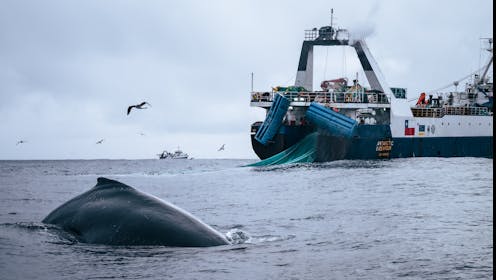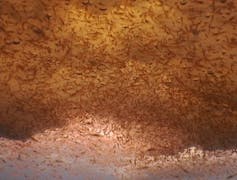Whales are recovering from near extinction, but industrial fishing around Antarctica competes for th
The Southern Ocean’s krill-rich waters attract multiple species of filter-feeding whales – and, increasingly, fishing boats.

The Southern Ocean encircling Antarctica is the world’s largest feeding ground for baleen whales – species like humpbacks that filter tiny organisms from seawater for food. In the 20th century, whalers killed roughly 2 million large whales in the Southern Ocean. Some populations, like the Antarctic blue whale, were reduced by more than 99% and have been struggling to recover, even though most nations ended commercial whaling in the mid-1980s.
Today a new threat is emerging: industrial fishing for Antarctic krill – tiny swimming crustaceans, roughly 2 inches (60 millimeters) long. In a newly published study, colleagues and I found that competition with this burgeoning fishery may impede whales’ recovery.
I first learned about this issue in early 2022, when a colleague working aboard a cruise ship told me that he had seen approximately 1,000 fin whales feeding on krill near the South Orkney Islands, just north of Antarctica. This was probably the largest aggregation of baleen whales seen since the 1930s, at the peak of industrial whaling.
My friend also reported that four enormous fishing boats were weaving among the huge group of whales, with large nets deployed. Like the whales, they were fishing for Antarctic krill.

Because the Southern Ocean is so remote, few people realized that krill fishing was competing directly with whales. Together with colleagues from Stanford and the University of Washington, we wrote about this observation in 2023 to draw attention to the potential threat to recovering populations.
We were soon contacted by Sea Shepard Global, a nonprofit organization that works to protect marine wildlife and had been monitoring this situation for several years. They reported that direct overlap between foraging whales and active fishing operations was common.
Now, krill fishing is on the verge of expanding. Along the Antarctic Peninsula, the fishing industry has proposed increasing the catch limit fourfold, from 155,000 tons to 668,101 tons annually.
Nearly all of this catch is used to make two products: fish meal for aquaculture, and omega-3 dietary supplements. Most of the fish meal feeds farmed salmon, which develop their familiar pink color from consuming the food.
Meanwhile, whales are competing with fishing boats for the animals’ sole food supply. Whales feed for roughly 100 days out of each year; depending on the species, an adult whale may consume 1 to 6 tons of krill in a day.
Most baleen whales use a strategy called lunge feeding: They swim rapidly toward a swarm of krill, opening their enormous mouths at the exact right moment. Then they close their jaws and force the seawater out through the bristly baleen plates in their mouths, filtering the krill from the water.
This behavior consumes a lot of energy, so the whales target large, dense swarms of krill – and so do fishing boats. From 2021 through 2023, four humpback whales died after becoming entangled in krill fishing nets.
The Commission for the Conservation of Antarctic Marine Living Resources, an international organization that manages use of the Southern Ocean, is required to ensure that whales and other krill-dependent populations are not harmed due to fishing. However, the commission operates by consensus, so if one member state opposes an action, nothing changes.
Member states have stalled proposals to create marine protected areas in the Southern Ocean and regulate krill fishing more tightly. A U.S.-led coalition is pressing for stricter limits, but Russia and China have resisted. Our work shows that if Antarctic krill fishing expands without strict guardrails to protect wildlife, baleen whales’ fragile comeback could be halted or even reversed.
Matthew Savoca does not work for, consult, own shares in or receive funding from any company or organization that would benefit from this article, and has disclosed no relevant affiliations beyond their academic appointment.
Read These Next
Data centers need electricity fast, but utilities need years to build power plants – who should pay?
How many data centers will be built – and how much electricity they’ll need – is uncertain. Being…
Sharks and rays get a major win with new international trade limits for 70+ species
Sharks have had a tough time since the 1970s, when overfishing, habitat loss and a growing trade in…
A Colorado guaranteed income program could help families, but the costs are high
A few hundred extra dollars a month would go a long way for many Coloradans.





